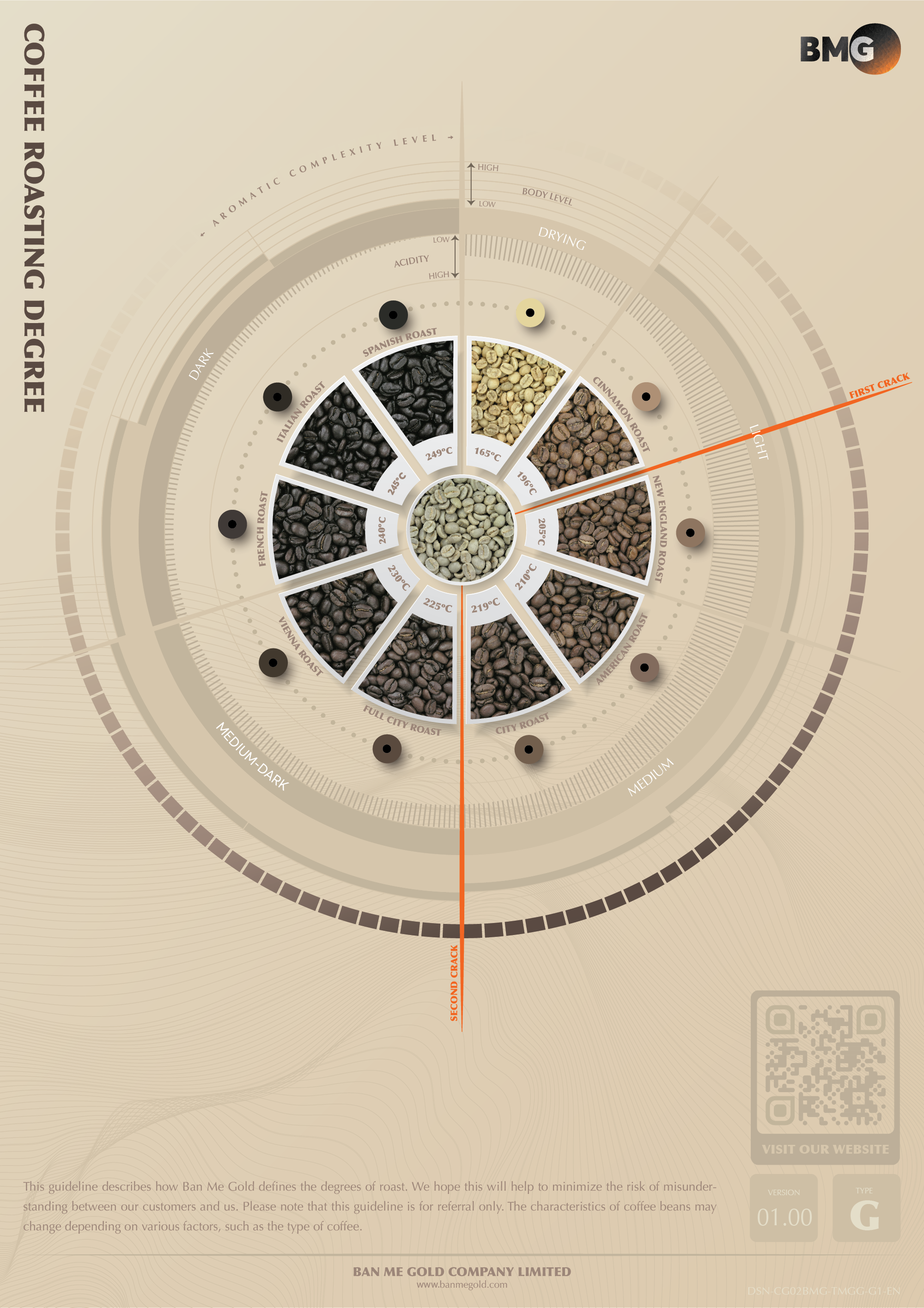01.
Brief
Coffee roasting is the process of creating the transformation of chemical components in the coffee beans through changes in heat. The diversity in coffee flavours is due to more than 1,000 chemical compounds (discovered) in the beans. And each type of coffee will have its own characteristic flavour factors because of the differences in biology, soil, and care. Therefore, for Ban Me Gold or any coffee roaster, coffee roasting is an endless journey of discovery and experimentation.
At Ban Me Gold, we continually improve our production techniques, machinery and coffee knowledge. Develop processes as well as optimal methods in production activities. At the same time, we are raising awareness and passion toward the value of enjoying coffee for employees.
This article aims to briefly introduce the process and basic elements in the roasting process in Ban Me Gold.
02.
Our Process
At Ban Me Gold, the coffee roasting process consists of seven basic steps. Steps 01 and 07 are only done once or periodically according to the number of batches.
01 - Preparation
For uninterrupted roasting, we always do
- Prepare the type and quantity of coffee to be roasted according to the plan;
- Check, start and set up the roaster for roasting;
- Check parameters of coffee to be roasted and re-check some parameters (Section 04);
- Prepare tools and equipment for the roasting process such as moisture meter, evaluation sheet.
- And some other tasks.
02 - Roasting & Adjustment
After the preparation, we conduct a continuous roasting process. Green coffee is pushed onto the roaster tank by the feeder to wait for roasting, while another batch is being roasted in the drum.
Although the machine is automatically roasting according to the profile that we have calculated and preset, the staff still has to continually check the coffee bean progress and make adjustments if there is any deviation.
03 - Cooling
Once the desired requirements and results have been achieved, the coffee beans are rinsed into a cooling tray to ensure the flavour will not change any more due to their inner heat. Depending on the type of coffee and taste requirements, the wind, water and time settings for cooling vary accordingly.
04 - Sorting Foreign Matters
The presence of foreign matters is inevitable. Usually, for natural or dry processing methods, foreign matters such as rocks are often mixed. This ratio is very rare for wet processing method.
The foreign objects are filtered at the feeder once, and we continue to remove the remains after the cooling step. They are usually stones of similar size and mass to the green coffee beans. The roasting process causes the beans to change in volume and size, so we can easily remove these foreign objects.
05 - Evaluate & Keep Coffee Samples
The coffee is then poured into silos and extracted a part of it for evaluation and keep as a sample. It will help us evaluate and identify problems if a mistake occurs.
06 - Resting
Coffee is stored in silos, protected from light and exposed to air. After roasting, the coffee releases C02 gas, which can take weeks. Resting times usually range from 24 hours or more. This difference depends on the type of coffee and the roast degree. The resting process will help develop the coffee taste better.
07 - Cleaning Equipments
Last but not least, cleaning machines and equipment helps increase the machine’s duration, ensuring hygiene and safety for the production process.
03.
Degree of Roast
Coffee Roasting Degree / Level is a common way to indicate the maturity of a roasted coffee bean. There are three signs:
- Based on colour changing due to Maillard, Caramelization and Carbonization reactions.
- Based on the sound, there are two marks: First Crack and Second Crack.
- Based on the scent emitted by the beans through each roasting stage.
Each level of roasting will evoke different aspects of flavour in the coffee bean. And Depend on the desired taste, brewing method as well as the nature of the coffee to choose the appropriate roasting method.
The figure below is our basic reference for the definition of roasting degree.

04.
Crucial Factors
As mentioned in section 02, the factors described here affect the roasting process and the coffee bean’s quality after roasting. Knowing these parameters helps to ensure the coffee’s flavour and stability.
01 - Type & Origin of Coffee
Each type of coffee will have different characteristics, and depending on the land will have different typical traits. For an instant, it is the distinction between Arabica and Robusta.
02 - Preliminary Processing
Knowing the method of preliminary processing will understand some particular attributes of the coffee. Each method affects the flavour of the beans differently and thus also affects the roasting process as well as cup quality.
03 - Harvest Time
If well preserved according to standards, green coffee will have a shelf life of up to 5 years. Most flavours will remain in the beans for up to 3 years. Most of the good characteristics of coffee beans will remain in the first year from harvest. Therefore, Ban Me Gold only chooses coffee to be harvested and stored within one year for production.
04 - Size, Density & Moisture
These three factors will significantly influence the heat regulation during roasting. The density and humidity usually fluctuate depending on the region, season or method of preliminary processing.
05 - Taste, Aroma & Brewing Method
Knowing the requirements of flavour and brewing method will determine the degree of roast. For example, with an Espresso requirement, the regular coffee will be roasted between City and Vienna as described in section 03.
06 - Roaster & Auxiliary Equipment
And finally, roasting machines and auxiliary equipment play an essential role in accomplishing requirements and evoking desirable properties in the beans. Therefore, Ban Me Gold chooses a reputable roaster from Europe to ensure the machine’s stability and uniformity. Besides, we also ensure the cleaning and maintenance of the machine and equipments.
05.
Coffee Grinding
Coffee flavour preserves best when it is in bean form. However, ground coffee offers more convenience. With the proper preservation method, ground coffee still ensures a good taste throughout the product’s shelf life. At the industrial level, Ban Me Gold must ensure many technical factors in correspondence with output such as grinder temperature and powder uniformity.
Below is a table of reference for grinding corresponding to the brewing method.

06.
Sample Roasting
Roasting is a crucial step in Ban Me Gold’s coffee production process. In addition to providing customers with sample products for comparison and adjustment. Roasting Sample helps us study the properties and flavours of coffee beans deeply, then apply them to commercial products and accomplish customer requirements. Moreover, sample roasting is also an essential step in coffee quality management, ensuring large batches’ stability.
07.
Technique & People
Even with the machines support the roasting process, it would be a huge mistake not to mention the people who operate them. The coffee’s control and processing need to be continuously checked and adjusted according to their judgment.
The coffee journey requires a balance between technology and art, if too inclined to one side, it will create incomplete products. Therefore, Ban Me Gold always focuses on personnel training. In addition to providing scientific knowledge, we always strive to create a passionate and creative environment in which people can feel the wonderfulness of coffee.
Interested in working with us?

